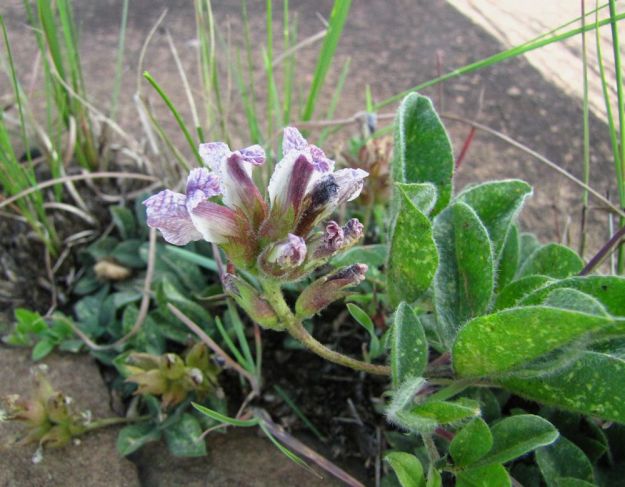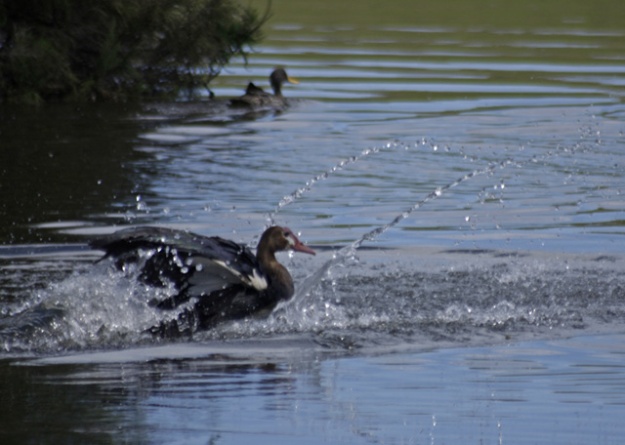Dieter Rowe Setz – Wakecroft Farm
This bat must have been very tired to sleep on the fence post all day.
This juvenile malachite Kingfisher? (more like Halfcollared Kingfisher) miscalculated his maiden flight and flew into the glass door. It landed right in front of one of the cavalier Spaniels, who picked it up and wanted to have some early morning fun. By the time i managed to get out the door, thinking the poor bugger has broken it`s neck, all the other Dogs joint in the fun. When I examined the bird it was still unconscious. Carrying it into the bedroom it woke up unharmed. After posing for the Camera it happily flew away.
With all the mist and rain in December we were blessed with patches of 2 different Bolete. The one in this pic being the Gyroporus castaneus or Chestnut Bolete. They all ended up on our family menu and were thoroughly enjoyed by everybody.
This one being the “King” of the Bolete, Boletus edulis came up in early December under one of our old oak trees in a patch of 6 specimens. What a delicious meal they ended up as.
To crown it all, this Mushroom I spotted on one of my morning walks from 200 m away. Agaricus arvensis or Horse Mushroom weight in at 760 gram and a diameter of 30cm of pure delicious, giant, firm fleshed beauty. It served us for more than a week on our versatile menu.
Nikki Brighton – Old Kilgobbin Farm
Mammals seen: Reedbuck, Oribi, Bushbuck, Common Duiker, Samango monkeys, giant grey mongoose, scrub hares. Heard jackals and tree dassies.
Birds heard Blue and Crowned Cranes, Fish Eagle, Burchell’s Coucal, Buffspotted Flufftail, Redchested Cuckoo, Black African Cuckoo, Klaus Cuckoo, Crowned Eagle, Emerald Cuckoo. Saw the usual birds, nothing out of the ordinary. Lots of Summer Flowers including Satyrium longicauda,
Pearsonia grandifolia (I think),
Scilla Nervosa,
Scabiosa columbaria,
Zaluzianskya natalensis,
Cyanotis speciosa,
a mauve bell flower which I haven’t identified – unfortunately, I didn’t note the leaf shape. Anyone have an idea?
Interesting observations during a walk on Inhlosane this month included: a Natal red rock rabbit, Schizoglossum flavum, Delospermum caespitosum,
Cerastium capense,
Cycnium racemosum
Giles Collins – Hastings Farm
A lovely sighting of 3 Wattled Cranes above Hastings farm on the 15th Dec 2013 (behind Inhlozane). 2 adults and a juvenile with rings – left leg: white; right leg: orange, green, blue. Also a Denhams Bustard and a pair of Blue cranes.
Sandra and Pat Merrick – Albury Farm
Found many nests. Found where my Yelloweyed canary was laying. 2 eggs in nest in plain tree. Hatched out 2 chicks on 13th december and who disappeared after xmas. Wagtail nest with 2 eggs, next to stream, hatched out 10th december. One adult chick flew off a few days ago. European swallow hatched out one chick on 15th december. (broken egg shell on window sill). Natal francolin running through garden one misty morning.
Male malachite sunbird chased female black sunbird into my bedroom window. She sat stunned for ten minutes. I opened the window to pick her up to check her out but she flew off thank goodness.
A reed cormorant sitting on our dead tree next to stream one cold misty morning. Sat for hours not moving and did not seem to catch anything to eat.
A number of white stork arrived mid december. The kikuyu had just been cut and baled and they were walking the land looking for insects.(photo)
Pat saved a female malachite sunbird in our garage. A red bishop arrived on the lawn digging for worms and insects. First time we have seen one here – (photo)
One morning a grey heron arrived on the lawn and was chased away by our dogs. Ten minutes he was back very determined that he was going to get his meal at the stream. He walked thru the garden and up the stream and spent 2 hours looking for crabs and frogs (photo)
We have found many Kowe’s around the farm (photo) probably due to the abundance of rain.
Lots of painted reed frogs (photo) On xmas day took the grandkids to the dam. Found a pale yellow tree frog clinging to the side of the dam bank. He jumped in water and swam around for a few minutes. When he climbed out, we were amazed to see he had now changed colour and had stripes and became a painted reed frog. I never knew they could change colour like a chameleon. (I had not had anything to drink at this stage, and had witness’s to prove the colour change!)
A steppe buzzard sits on our dead tree next to stream every few days, for 5 hours at a time. Occasionally see him catch something in the grass.
I have a baby natal red rock rabbit who sleeps in my formal garden by day. The cats chased it out of its hiding place 2 weeks ago. They are not sure what this animal is who hops around. I saw him again yesterday and he has doubled in size. Just can’t get a photo of him as he ducks into my long reed grass. A samango monkey sat on some rocks outside my garden for awhile (photo)
My most amazing and exciting news is that our pair of blue crane who hatched out a chick last year arrived back on the farm on the 23rd december with one chick who was about 1 week old. They nested on a neighbouring farm this year. They have been here ever since. I follow their progress every day. They are amazing parents. Chick runs between both parents for food. He has a voracious appetite and eats every few minutes. Every ten minutes or so, the female rests with chick beneath her tail feathers while the male grazes some way off and then returns to feed chick.
They have now found the rumevite lick (for our nguni cattle) in a drum in front of our house. They really enjoy eating from it as they return constantly throughout the day (photo) They spend a lot of time digging for grubs with their beaks as I see soil flying up.
Another exciting siting was a european roller (photo) Amazing colours when he flies. He spends a lot of time sitting on barbed wire fence near the house.
Saw a fish eagle on pine tree at dam harrassing the Hadedas who have been nesting there.
Rob Coulson and Vonnie Munk – Hastings Farm
Have just returned from spending Christmas week at Hastings Farms, Upper Dargle. How privileged we were to have excellent sightings of all the Cranes resident on the farm . A beautiful pair of Blue Cranes, A pair of Wattled Cranes and their Young teenager and the Grey Crowned Cranes with a flock of Egrets feeding next to Hastings dam. There was also a Spoonbill feeding on the bank of Loch Maria.
Rose and Barry Downard – Oak Tree Cottage
Birds: Paradise Flycatcher, Malachite Sunbird, Amethyst Sunbird, Lesser and Double-collared Sunbirds, Guineafowl, Egyptian Geese, African Cuckoo, Long-crested Eagle, Kites, Grey Herons, Crowned Eagle, Natal Francolin, Olive Thrush, Red Bishops, Bronze Mannikins.
Following a cold and rainy week in December we found four dead Drongo chicks on the ground under a plane tree where the Fork-tailed Drongos have a nest. The chicks were half-grown with feathers, but the cold, wet weather must have been too much for them to survive. Heard: Burchell’s Coucal.
Insects: Carpenter bees, dragonflies, damselflies, butterflies, caterpillars and moths including Laelia octophora – Eight-spot Tussock moth.
Mammals: Reedbuck, Duiker. Seen Jackal scat in our orchard, plus another scat, similar in size to Jackal scat, but very dry and consisting mainly of finely crushed shells, locusts, beetles and other dry matter – Mongoose perhaps?
Graham Griffin – Dargle Farm
Spotted 8 baby Dassies recently (part of the Dargle Dassie Release Project) which is very good news. There are three colonies on Dargle farm now.
Sue Robinson – Ivanhoe
Some of our flock of 38 Wattled Crane and a couple of Blue Crane which stay on Ivanhoe most of the time.
Also a photo of a Red-Necked Franklin.
Ashley Crookes – Copperleigh Farm
Spur-winged Goose landing on Mavela dam, with Yellow billed-duck in background.
orange and black grasshopper
red and green grasshopper
baby black and green grasshoppers (nymphs)
spider web with morning dew.
It has also been suggested to the Dargle Conservancy by Pat McKrill that we include more road kill sightings as it is a very important form of data collection to help determine what creatures we have moving in our area (perhaps some things that are not normally seen). For more information on a very useful Phone App to assist with this data collection, see this article:
http://kzncablog.wordpress.com/2013/11/20/roadkill-data-collection/







































Rich news of sightings in the Dargle, so wonderfully described; and illustrated with the most wonderful photos. A joy to see and a privilege to receive and read about. Many thanks
LikeLike
Those mushrooms look yummy. I ador them. Occasionally Kowe’s come up in a particular spot in my La Lucia garden. I’m moving in a few months to Durban North and I’ve been wondering; if I scooped up some of the soil in that area and relocated it to the new property would the spoors might travel with me? Does anyone know?
LikeLike
Feel exactly as above recipient and want to also personally say “Thankyou” for sharing your wildlife and nature photos – as good as a trip to the library and being engrossed and transported into another world.
LikeLike
Great Crane sightings this month in the Dargle…great stuff. All these crane sightings I capture so please remember to capture as much detail as possible, also if you’d like to send me additional info like GPS coordinates then please do so on tanyas@ewt.org.za. The sighting reported by Giles is of the family of Wattled Cranes that bred on Hastings farm last year. We colour ringed the chick towards the end of last year and very happy to see that the pair and chick are doing well!
The combination of the rings (colours and leg placement) provide a unique identification method that allows us to identify individuals over time. So the combination seen by Giles on the chick will be unique to that bird and whenever it is re-sighted we capture the information that will allow us to determine essential population dynamics i.e. survival, age of first breeding, movement and sex ratios etc.
LikeLike
Painted Reed Frogs are so beautiful!! They are able to change colour. During the dry season or when it is very sunny, and especially during high temperatures, Painted Reed Frogs (Hyperolius marmoratus) turn white and this helps to reflect sunlight. This colour comes from the food that H. marmoratus consumes. Food wastes are converted into substances called purines. Small purine platelets form crystals in their pigment cells in their skin. These crystals act as interference reflectors, and reduce the heat load by reflecting sunlight from the skin. When the frog jumps in the water, it cools off and therefore changes its colour to those amazing patterns for which reed frogs are famous.
LikeLike
Pingback: Dargle Wildlife Sightings – May 2014 | Midlands Conservancies Forum